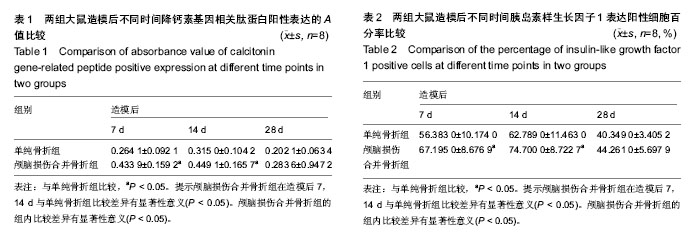| [1] Genet F, Marmorat JL, Lautridou C,et al. Impact of late surgical intervention on heterotopic ossification of the hip after traumatic neurological injury. J Bone Joint Surg Br. 2009; 91(11):1493-1498.
[2] Boes M, Kain M, Kakar S,et al. Osteogenic effects of traumatic brain injury on experimental fracture-healing.Bone Joint Surg Am. 2006;88(4):738-743.
[3] Morley J, Marsh S, Drakoulakis E. Does traumatic brain injury result in acclerated fracture healing. Injury. 2005;36: 363-368.
[4] Ducy P, Amling M, Takeda S, et al. Leptin inhibits bone formation through a hypothalamic relay: A central control of bone mass. Cell. 2000;100: 197-207.
[5] 张连方,齐进,王晋申,等.小鼠闭合性股骨骨折模型的建立与评估[J].中国矫形外科杂志,2010,18(2):143-146.
[6] Masi L, Brandi ML.Calcitonin and calcitonin receptors. Clin Cases Miner Bone Metab. 2007;4(2):117-122.
[7] Song Y, Bi L, Zhang Z,et al.Increased levels of calcitonin gene-related peptide in serum accelerate fracture healing following traumatic brain injury. Mol Med Rep. 2012;5(2): 432-438.
[8] Schober ME, Ke X, Xing B,et al. Traumatic brain injury increased IGF-1B mRNA and altered IGF-1 exon 5 and promoter region epigenetic characteristics in the rat pup hippocampus. J Neurotrauma. 2012;29(11):2075-2085.
[9] 王新,宋跃明,裴福兴.中枢神经损伤大鼠骨痂中神经肽的表达[J].中国矫形外科杂志,2006,14(16):1261-1263.
[10] Baykara B, Aksu I, Buyuk E,et al.Progesterone treatment decreases traumatic brain injury induced anxiety and is correlated with increased serum IGF-1 levels; prefrontal cortex, amygdala, hippocampus neuron density; and reduced serum corticosterone levels in immature rats. Biotech Histochem. 2013;88(5):250-257.
[11] Bhandari M, Guyatt GH, Khera V, et al. Operative management of lower extremity fractures in patients with head injuries.Clin Orthop Relat Res. 2003;(407):187-198.
[12] Giannoudis PV, Veysi VT, Pape HC ,et al. When should we operate on major fractures in patients with severe head injuries? Am J Surg. 2002;183(3):261-267.
[13] Mrozek S, Gaussiat F, Geeraerts T.The management of femur shaft fracture associated with severe traumatic brain injury. Ann Fr Anesth Reanim. 2013;32(7-8):510-515.
[14] Liu X, Zhou C, Li Y, et al. SDF-1 promotes endochondral bone repair during fracture healing at the traumatic brain injury condition. PLoS One. 2013;8(1):e54077.
[15] Probst C, Mirzayan MJ, Mommsen P,et al.Systemic inflammatory effects of traumatic brain injury, femur fracture, and shock: an experimental murine polytrauma model. Mediators Inflamm. 2012;2012:136020.
[16] Yang TY, Wang TC, Tsai YH, et al.The effects of an injury to the brain on bone healing and callus formation in young adults with fractures of the femoral shaft.J Bone Joint Surg Br. 2012;94(2):227-230.
[17] Wang L, Yuan JS, Zhang HX, et al. Effect of leptin on bone metabolism in rat model of traumatic brain injury and femoral fracture.Chin J Traumatol. 2011;14(1):7-13.
[18] Song Y, Bi L, Zhang Z, et al.Increased levels of calcitonin gene-related peptide in serum accelerate fracture healing following traumatic brain injury.Mol Med Rep. 2012;5(2): 432-438.
[19] Chhen YQ, Sun TS, Liu J. Observation on biochemical indicator of multiple organ functional dysfunction after femoral shaft fracture combined with brain injury in rats. Zhongguo Gu Shang. 2011;24(5):404-406.
[20] Jiang X, Zhang L, Sun X, et al. Effect of brain injury on expression of PDGF in fracture healing process in rats. Zhongguo Xiu Fu Chong Jian Wai Ke Za Zhi. 2008; 22(10): 1227-1231. |
